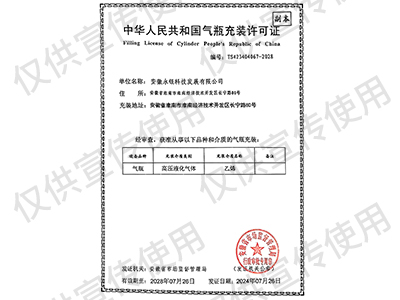Electronic-grade gas
![]()
The technical indicators of electronic grade nitrogen trifluoride (NF₃) need to be strictly classified according to application scenarios (such as semiconductor etching, cleaning, photovoltaics, etc.). The core indicators are as follows:
1. Basic purity level
|
grade |
Purity requirements (volume fraction) |
Applicable scenarios |
|
Basic electronic grade |
≥99.99%(4n) |
Photovoltaic cells, LCD panel manufacturing, etc. |
|
High-purity |
≥99.996% (4n6) |
Semiconductor process above 28nm |
|
Super high-purity |
≥99.999%(5N) |
Advanced process (below 14nm), cold wall CVD chamber cleaning |
|
Cutting-edge |
≥99.9999%(6N) |
3nm/5nm chip manufacturing, photoresist stripping |
Note: About 92.8% of the electronic grade NF₃ in the world are concentrated in the 5N level, and the 6N level has a market share of less than 8% due to process difficulty.
2. Key impurity limit (taking level 5N as an example)
|
Impurity type |
Limit requirements |
The consequences of exceeding the standard |
|
Oxygen + Argon (O₂+Ar) |
≤0.5ppm (5N level requirements ≤1ppm) |
Abnormal oxide film on the wafer surface, threshold voltage drift |
|
Moisture (H₂O) |
≤0.5ppm (dew point ≤-76℃) |
Accelerate cavity corrosion and reduce etch selectivity |
|
Hydrogen fluoride (HF) |
≤0.1ppm |
Corrode the vacuum pump oil, damage the silicon lattice structure |
|
Carbon monoxide (CO) |
≤0.5ppm |
Reduce film deposition uniformity |
|
Total metal ions |
≤1ppb (Na/Fe/K, etc.) |
Induces circuit short circuit and device leakage |
|
Particulate matter (≥0.1μm) |
≤0.1 units/mL |
Causes chip surface defects |
|
Hydrolyzable fluoride |
≤0.03mg/l |
Polluting wafer surface |
Special control items:
Phosphine (PH₃) and hydrogen arsenide (AsH₃) need ≤0.05 ppb (grade 6N)
Greenhouse gas potential (GWP) ≤17,000 (refer to IPCC standard)
3. Packaging and storage and transportation standards
Container requirements
Nickel-based alloy/chromium-molybdenum alloy cylinder, electrolytic polishing and passivation treatment of inner wall.
The valve is made of copper alloy and is equipped with a double blocking and leakage prevention device.
Filling standards
Filling pressure ≤1.5 MPa, three-stage pressure stable filling method is adopted
Filling coefficient ≤0.76 kg/L (trifluoromethane analogy requirements)
Storage and transportation conditions
Store in an environment with a humidity of 45–65% from light.
Pressure fluctuations need to be monitored during the transportation process (bumping frequency ≤2.5 times/second).
Leak alarm threshold is 0.5%, explosion limit is 2.3–82%.
4. Testing methods and standard basis
|
Testing items |
method |
Standard basis |
|
Purity and impurity gas |
Helium ionization gas chromatography (detection limit 10⁻⁶) |
GB/T28726 |
|
moisture |
Optical cavity inactivity spectroscopy (accuracy ±0.01ppm) |
GB/T5832.3 |
|
Metal ions |
ICP-MS (detection limit 0.1ppb) |
SEMI C10/SUT 15587 |
|
Particulate matter |
Laser particle counter (0.1–10μm) |
ISO 21501 |
|
Hydrolyzable fluoride |
Ion chromatography (detection limit 0.03mg/L) |
GB/T 31995 |
Implementation standards:
Purity and safety: GB/T 21287-2021 (replace 2007 version)
Transportation safety: TSG R0006 "Technical Supervision Regulations for Gas Bottle Safety"
5. Application risk correlation
Semiconductor etching:
HF >0.1 ppm will corrode the vacuum system, and O₂ >1 ppm will cause wafer threshold voltage drift.
Cavity cleaning:
Moisture >0.5 ppm reduces the cold wall cleaning efficiency, and metal residue >1 ppb causes device failure.
Photovoltaic manufacturing:
Particulate matter exceeds the standard and causes microcracks on the surface of solar cells, and the photoelectric conversion rate decreases by ≥15%.
A wafer factory suffered a scrapped entire batch of chips due to an oxygen content exceeding the standard (5 ppm), with losses of more than 10 million US dollars.
- Previous:Hydrogen bromide
- Next:Tungsten hexafluoride





